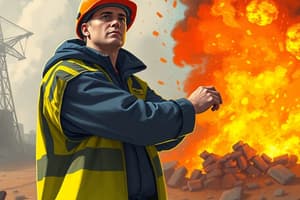Podcast
Questions and Answers
According to the provided text, who is ultimately responsible for establishing Hot, Warm, and Cold Zones during an incident?
According to the provided text, who is ultimately responsible for establishing Hot, Warm, and Cold Zones during an incident?
- All Personnel
- Supervisors
- Incident Command (correct)
- Company Officers
What is the primary purpose behind the establishment of incident hazard zones?
What is the primary purpose behind the establishment of incident hazard zones?
- To prevent public access to the incident scene.
- To delineate the area requiring immediate action by firefighters.
- To efficiently manage firefighting resources.
- To ensure the safety of personnel involved in the operation. (correct)
Which of the following is NOT a requirement for personnel operating within the Warm Zone?
Which of the following is NOT a requirement for personnel operating within the Warm Zone?
- Fire helmet
- Steel-toed shoes
- Full turnout gear (correct)
- Gloves
What is the minimum level of PPE required for operating in the Warm Zone when smoke is present?
What is the minimum level of PPE required for operating in the Warm Zone when smoke is present?
What is the term used to describe the forward staging position located just outside the immediate hazard zone?
What is the term used to describe the forward staging position located just outside the immediate hazard zone?
Which of the following is permitted within the Cold Zone?
Which of the following is permitted within the Cold Zone?
According to the provided information, what role do supervisors play in ensuring personnel safety during incidents?
According to the provided information, what role do supervisors play in ensuring personnel safety during incidents?
Based on the SOP, in which zone would you expect to find firefighters operating in full turnout gear and SCBA?
Based on the SOP, in which zone would you expect to find firefighters operating in full turnout gear and SCBA?
Under what condition should personnel enter the Hot Zone without wearing air supply?
Under what condition should personnel enter the Hot Zone without wearing air supply?
What is the appropriate footwear requirement for personnel working in the Warm Zone?
What is the appropriate footwear requirement for personnel working in the Warm Zone?
Which statement is true regarding personnel in the Cold Zone?
Which statement is true regarding personnel in the Cold Zone?
What gear should be worn by a company assigned to On Deck in preparation for entering the Hot Zone?
What gear should be worn by a company assigned to On Deck in preparation for entering the Hot Zone?
In what scenario is it mandatory for personnel to wear eye and hearing protection in the Warm Zone?
In what scenario is it mandatory for personnel to wear eye and hearing protection in the Warm Zone?
Flashcards
Hot Zone
Hot Zone
The area immediately surrounding the incident where the highest risk of hazards exists.
Warm Zone
Warm Zone
An area surrounding the Hot Zone where a lower level of hazards exists. Personnel in this zone may need to wear protective gear but are not required to wear SCBA.
Cold Zone
Cold Zone
The area furthest from the incident where personnel are safe from hazards. Personnel in this zone are not required to wear protective gear.
On Deck Assignment
On Deck Assignment
Signup and view all the flashcards
SCBA Requirement in Hot Zone
SCBA Requirement in Hot Zone
Signup and view all the flashcards
On Deck
On Deck
Signup and view all the flashcards
Incident Commander (IC)
Incident Commander (IC)
Signup and view all the flashcards
Supervisors
Supervisors
Signup and view all the flashcards
Full PPE
Full PPE
Signup and view all the flashcards
IDLH (Immediately Dangerous to Life and Health)
IDLH (Immediately Dangerous to Life and Health)
Signup and view all the flashcards
Study Notes
Incident Hazard Zones SOP
- Purpose: Establish procedures for incident hazard zones where there is an Immediately Dangerous to Life or Health (IDLH) environment, collapse zone or other hazardous areas. This applies to all such incidents.
Zones
-
Hot Zone:
- Extremely hazardous area, including IDLH or collapse zones.
- Initially defined by the closest apparatus to the incident.
- Full Personal Protective Equipment (PPE) required: Turnouts, helmet, hood, boots, gloves, and SCBA with personal mask.
- Public is prohibited.
- If smoke is present, all personnel must wear SCBA. If no smoke is present, personnel must don SCBA under specific circumstances outlined in the policy.
-
Warm Zone:
- Area between Hot and Cold Zones.
- Common staging area for first-arriving units and command vehicles.
- Minimum PPE required: steel-toed shoes, pants, helmet, and gloves. Additional PPE may be required based on conditions.
- SCBA may be required if smoke is present.
- Public access restricted.
- Area between Hot and Cold Zones.
-
Cold Zone:
- Area beyond the staged apparatus and command vehicle.
- Separated by fire line tape and barriers.
- Public and media are allowed.
- Station uniforms can be worn.
- Safety vests are required if traffic is present.
- Level of protection may change based on conditions.
On Deck
- Forward staging position just outside the hazard zones.
- Crews supervised by Division/Group supervisors or company officers.
- Remain on deck until assigned by IC or Division/Group supervisor.
PPE Policy
-
Hot Zone:
- Full PPE, including SCBA, required.
- Personnel must be fully equipped to deal with IDLH atmospheres, oxygen deficiencies, active fires, toxic products, confined spaces (unmonitored and unventilated), and overhaul.
- SCBA use is mandatory in the presence of smoke.
-
Warm Zone:
- Minimum PPE: steel-toed shoes, gloves, pants, and helmet.
- Turnout pants and boots required instead of summer uniform or workout gear.
- Reflective vests or turnout jackets required if traffic is nearby.
- Eye and hearing protection as necessary.
-
Cold Zone:
- Station uniforms permitted.
- Safety vests required if traffic is present.
- Fire line tape/barriers keep the public out of the Warm and Hot zones.
-
Rehab: Personnel assigned to rehab are exempt from PPE requirements as rehab must be in the Cold Zone.
-
On Deck: On Deck companies stage in the Warm Zone wearing full PPE and are prepared for immediate assignment to the Hot Zone.
Studying That Suits You
Use AI to generate personalized quizzes and flashcards to suit your learning preferences.




